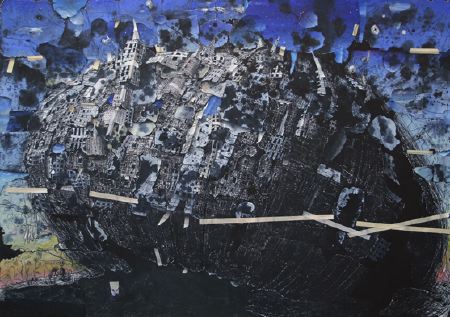
Do You Come Here Often?, 2004-2006, oil on canvas

What Should I Paint?, 2004-2006, oil on canvas

What Should I Paint? (detail)
Gerry Bergstein—as some of you may already know—is one of my favorite living artists. I wrote an excitable (if not altogether approving) review of his recent show This Is Your Brain on Art at Boston’s Gallery NAGA. I’ve learned a lot of things from him, although not so much from taking his painting class at the School of the Museum of Fine Arts (also in Boston). Rather, I’ve learned by absorbing his thoughtful and intoxicating images over the last eight or so years.
In response to a post by Colin Jago on religious art, I once spat out that “the role of art is to present compelling fictions”(comment #23), further claiming that “internal coherence is more important than any resemblance the work might have to something outside of it”. Later (#31), I added the following clarification:
By “fiction”, I don’t mean necessarily a conventional narrative. I mean that works of art create their own worlds, with their own rules.
I don’t consider this to be a “real” definition of art, a statement of necessary and sufficient conditions for arthood (I don’t believe such a definition is possible.) But it does point in the direction of what I find most valuable in art. My guess is that many other people feel the same way (but do let me know if otherwise).
I like a broad variety of styles and approaches. Categories and oppositions like “abstraction vs. representation” or “modernist vs traditionalist” are useful signposts, but they appear to have little to do with artistic value. On the face of it at least, Bergstein’s work couldn’t be more different from that of Syau-Cheng Lai’s. Bergstein’s is representational, implicitly narrative and “literary”, whereas Lai’s is abstract, deliberately analogous to music. His are often loud and bombastic, while hers tends to be quiet and delicate. He works primarily with oil on canvas, she with a variety of media on paper. I don’t want to paper over (pun intended) such differences or suggest that all art is fundamentally the same. But I do think that both artists—like most others that I admire—are talented and ambitious world-builders.
The world-building in question is at root visual. Bergstein’s work cites or alludes to a generous (excessive?) assortment cultural debris: stylistic borrowings and iconography from popular culture (e.g. The Simpsons) as well as from art history (Magritte, Bruegel, Pollock, Philip Guston, Ivan Albright…). Lai’s work refers to the real world as well; colors, tones, textures and patterns have the feel of familiar things. In both cases, what first draws you into the work is a internally consistent feel for space—both real and implied. If they don’t stand up at this level, they don’t stand up at all.
Gerry’s paintings make a particularly strong case for art as fiction, because they are—to a large extent—artworks about fictionalizing (art about art). His work in recent years has focused on images of mounds or towers. In the foreground of many of these stands a figure, facing away from the viewer. In This Is Your Brain:
The figure is Gerry himself, but he also acts as a stand-in for the viewer, a way of penetrating these forbiddingly dense vistas. In some pictures, he holds up a map or canvas, contemplating the scene before him. In others, he takes a more active role, interacting with the material of the cities themselves. In both cases, he is an explorer, trying to find a sense of place in world composed of dislocations and nested (ir)realities.
I’ll add that in addition to being an explorer, the Gerry figure is also a creator. The “map or canvas”—often depicted as a blank white rectangle—conflates the two. To make art is to explore its terrain.

Arthur,
Your definition of art is different from the other interpretations we have been discussing. Your “world-building” insight points to something I think we have been lacking in the previous definitions. It is not incompatible necessarily, but it adds another dimension, one that seems important and obvious once you point it out.
I’ve been looking at more images on the gallery site. Intoxicating is a good word for this work. Everything seems slanted and a bit unsteady. It would be interesting to live with this sort of work.
I like the notion of this artist as an explorer. The image of him standing before these structures with his blank canvas. That reminds me of early American landscape paintings with tiny people in front of these huge sublime landscapes.
http://artchive.com/artchive/C/church/rainy_season.jpg.html
I notice form the show description that he used mixed media. I wish I could see that a little more clearly. For example, does “What Should I Paint?” have ripped paper and masking tape on it?
These images make me reel back on my heels, literally! I get a sense of the enormity of the world presented in the images, and also apprehension of what lies within.
These are very moving works. Darkness, depth and space are very powerful.
Leslie,
Both of the paintings reproduced above are oil on canvas. The paper and masking tape that you see are trompe l’oeil, a Bergstein trademark. A few of the show’s smaller paintings–Roadmap, Babel, and Sitting in the Stars–are are oil on paper. Others are digital prints.
The Church comparison is an interesting one. I’ll have to give it some thought.
A Star War One artist, space ships and garbage collections.
I am trying to remember the artist who first starting veiling his pictures, here done with masking tape. It seems to be catching on in Europe. A German friend told me that an artist friend of hers recently exhibited his pictures partially veiled. She thought that they looked much better unveiled. I forgot the name of the artist – a Sicilian living in Cologne.
Birgit, I thought Star Wars too this morning, before I saw your comment. The second and third pictures show a world brusting at the seams, over populated, too urbanised, and the true natural world squeezed out of them. The paper and masking tape may be trompe l’oeil, but they seem to be helping to hold the world together, just. How does one find their place in an alien place?
We have a Gerry Bergstein painting (“The Canyon”, signed and dated 1983) coming up at our monthly sale August 18-19, estimate 6000-8000 Swedish crowns (some 1000 USD). Please visit http://www.uppsalaauktion.se for further information.